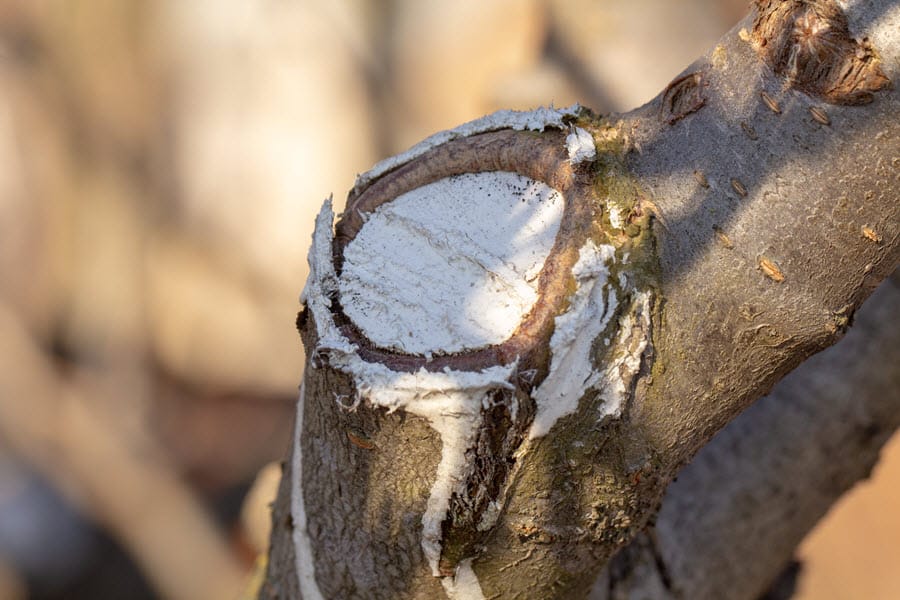
The other day, my attention was drawn to the question of what to put on a tree after cutting off the limb. My wife had remembered a time when her grandfather spoke about painting a tree wound with varnish, but she thought she must be misremembering. After all, that couldn’t be right, could it? Is this something you should put on a tree wound, or are there other ways to deal with it.
What Do You Put On A Tree After Cutting Off A Limb? It was once standard practice to paint a tree wound after trimming. However, it is now considered better to leave the tree to heal naturally, leaving the cut unpainted and there are only a few instances when anything should be applied to the cut.
Unfortunately for the trees in the garden of my wife’s grandfather, painting varnish, tar, or similar sticky substances onto the wound of a freshly made cut WAS considered the correct thing to do.
Fortunately, we now know that this is not a good idea, although there are a few exceptions. Here’s a rundown of what you need to know about making healthy cuts, post cutting care, and the circumstances in which applying something to a tree cut is the best thing to do.
What Do You Put On A Tree After Cutting Off A Limb?
Professional arborists, landscape gardeners, and horticulturalists are divided over the answer to this question. Generally speaking, they fall into two groups:
- Group One: This group believes that it is important to seal a tree wound after pruning. They have been taught that it is an effective way to prevent both potential decay caused by excess moisture and disease caused by the entrance of micro-organisms into the open wound.
- Group Two: This group is of the opinion that trees are best left to their own devices after pruning and that their natural healing abilities are sufficient to protect them from disease and decay.
Of course, this division between the experienced professionals is not especially useful for the enthusiastic but amateur gardener who is looking for informed advice to guide them. So let me guide you through what happens when you prune a tree, how trees recover from pruning and the ins, and outs of wound sealers. After this, you should be well equipped to make your own, informed decision about what to put on a tree after cutting off a limb.
What Happens When You Prune A Tree?
Trees and other woody plants have a well developed, natural response to damage. Their reaction is the same whether a wound is caused through natural causes, such as in the case of storm damage, or as the result of deliberate pruning.
The way in which a tree responds to damage is not the same as healing in the way that most people understand it. For example, when a person suffers a wound, their natural healing systems kick into gear and:
- Your blood clots to prevent excessive blood loss
- A crust forms over the wound to protect the body from disease-causing organisms.
- Under the crust healing takes place and the damaged tissue is replaced with new, healthy tissue which is integrated into the existing, surrounding tissue.
However, when a tree recovers from a wound it:
- Forms a special coating of tissue that both physically and chemically repels harmful organisms. This layer is made up of a complex substance called lignin. You can think of this a kind of glue that holds the cells of a tree together and makes the plant “woody .”
- Beginning at the edge of the wound and working towards the center, this tissue seals the wound off from the rest of the tree. This leaves the area of the wound encased in a kind of shell.
- New growth gradually spreads over the top of the wound shell but does not integrate with it.
So, people create new tissue that integrates with the existing and forms a seamless repair, while trees encase a wound in a capsule which remains forever sealed off from the rest of the tree.
Understanding this distinction is critical when considering using sealants on your tree.
What IS A Wound Pruning Sealer?
Unsurprisingly, anything that is used to cover-up the area exposed after pruning a tree is a wound pruning sealer. They do not have to be a commercially available product. Many gardeners utilizer home-made sealers, or products designed for other uses but used for this purpose – for instance, paint or varnish.
Also called pruning sealers, pruning paint, or wound paint, the products found online and in stores are thick liquids made to be painted onto the area where you have cut back your tree.
They claim to promote the healing of pruning cuts and minimize sap loss.
The majority of sealers are petroleum based although some may also contain asphalt and a new generation of sealers has begun to emerge with ingredients that sound much like cosmetics. Yes, you can now treat your trees wound with an application of sealer containing collagen or even aloe vera.
When Is A Wound Sealer Used?
Wound sealers are traditionally used immediately after you, or your professional gardener/arborist have removed a limb from one of your trees. The theory being that by sealing the wound quickly you minimize the risk of infection.
Though many gardeners used to apply wound dressings such as latex paint mixed with water to protect trees after pruning, current research has revealed that this is not beneficial. Wound dressings don’t prevent decay, disease or insect infestations as once believed. They may even prevent the wood from drying, which can spark fungal growth. If you want to apply a wound dressing for cosmetic reasons, you should at least make sure the paint is nontoxic.
How Can Pruning Sealers Be A Bad Thing?
Wound sealers do not, as was once previously believed, prevent disease, decay, or insect infestations. In some cases, sealers might even be harmful. For example, using a sealer on your tree can:
- Seal in any moisture, insects, and disease already present, promoting infection and decay.
- Prevent the wood from drying which can create the perfect conditions for fungal infections.
- Attract exactly the kind of organisms you are trying to exclude, because some may be drawn by the ingredients of the sealer.
- Stop or slow the natural “encasing” process of the wood, causing the tree stress and creating a longer window of vulnerability.
Should You Use A Wound Pruning Sealer At All?
In the majority of cases, it is best to leave a tree to heal itself. On average this will take a year or two, depending on the species, size of the cut, and any environmental factors which may have an impact.
However, sometimes:
You Should Use A Wound Pruning Sealer
For example, you may be forced to prune a tree during the spring or summer. This is not the best time to do your pruning. Winter is the optimal season for pruning your trees because their growth is at a minimum, or completely dormant, and the risk of disease is at its lowest. None the less, if the tree has sustained some damage or has branches that are crossing over and rubbing against each other, you may have no choice than to prune ASAP.
In this case, it may be prudent to use a sound sealer if the tree is going to otherwise be left especially vulnerable.
Another occasion is during periods of severe drought when a tree will have difficulty recovering because it is already having to conserve fluids. In this situation, a thin layer of sealer can help a tree seal in the little moisture it has.
Finally, if a limb has broken off, and the break is flush with the trunk, the tree will find it significantly more difficult to seal itself. As a consequence, a little sealer might be appropriate.
What Should You Do After Cutting Off A Tree Limb?
Before considering what to do after cutting off a limb, you should ensure you are pruning correctly.
You should always prune with sharp, clean tools to prevent injury, ragged cuts, and disease. Take care to clean your trimmers, saws, and pruning shears between uses, thoroughly drying them and storing them in a clean, dry place. This will minimize the possibility of introducing disease via dirty tools.
Place your cut at the base of the limb leaving a small collar of wood at the base. This is the point at which the branch grows out from the trunk and is a slightly swollen, raised area. Leaving this collar makes it easier for the tree to form it’s callous.
If pruning sealer/paint should not be your first line of response to help your pruned tree, what should you do?
- As soon as you have finished pruning give your tree a long hard drink of water. This will help it stay hydrated and eliminate one stressor that can impact wound recovery.
- Fertilize your tree as you usually would BUT avoid those with high levels of nitrogen, especially if you have pruned a number of limbs. While it might normally be appropriate, nitrogen bolsters leafy growth and this surge in growth, alongside the need to heal, can be too much for a tree, causing it to become weak, stressed, and vulnerable.
The Last Word
Generally speaking, you should leave a tree to recover natuurally after you have cut off a limb. There are a few circumstances where a wound sealer might be appropriate, but other than that you should focus on making the correct pruning cuts and supporting your tree in its own recovery process.
